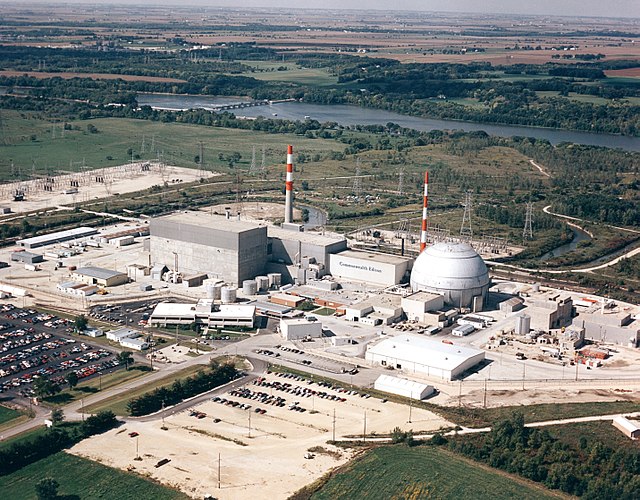The Salem nuclear power plant. (Photo: Peretzp)
In the latest legal action over the New Jersey Board of Public Utilities’ (BPU) April 2019 order providing subsidies to the Hope Creek and Salem nuclear plants, the state’s Supreme Court has declined to hear an appeal.
A still image from a three-part video tour of NuScale’s facilities. (Photos: NuScale Power)
When Utah Associated Municipal Power Systems (UAMPS) in 2015 announced its plan to develop the Carbon Free Power Project (CFPP) using NuScale Power’s modular light water reactor design, it envisioned the construction of a dozen 50-MWe modules for a plant that could produce a total of 600 MWe. The CFPP’s target output later rose to 720 MWe, when UAMPS opted to scale up to 60-MWe modules. In late June, the plans changed once again, as UAMPS participants chose to build 77-MWe modules but downsize the plant from 12 units to six, which would yield 462 MWe—about 64 percent of the 720 MWe that could have been generated from 12 of the 60-MWe modules.
The Dresden nuclear power plant (Photo: Nuclear Regulatory Commission)
As Illinois lawmakers continue to debate energy legislation that would allow the state’s Byron and Dresden nuclear plants to continue operation beyond this year, Exelon would like to remind everyone—including those legislators, no doubt—of what is at stake.
Nicholas Thompson of LANL helps set up the neutron clustering measurements at the Walthousen Reactor Critical Facility at Rensselaer Polytechnic Institute in Schenectady, NY. (Photo: LANL)
A statistically predicted tendency for neutrons produced inside fission reactors to form in clusters can cause asymmetrical energy production that is counterbalanced, at least in part, by the spontaneous fission of radioactive material in the reactor.
Rendering of the multipurpose building that will house the Nuclear Security Training and Demonstration Centre. (Photo: IAEA)
The International Atomic Energy Agency has broken ground for a new building designed to help countries combat nuclear terrorism in areas such as illegal material trafficking and physical protection of facilities.
Sequoyah nuclear power plant (Photo: Photorush/Wikimedia Commons)
In an evaluation report released last week on the Sequoyah nuclear plant’s chemistry/environmental program, the Tennessee Valley Authority’s Office of the Inspector General identified certain risks, both behavioral and operational, that could impact organizational effectiveness. Program behavior was assessed from interviews and field work conducted from September 21 through November 3, 2020, with operations assessed in February of this year.
Map of the PJM Interconnection territory in dark blue. Image: PJM
PJM Interconnection’s board of managers has approved the grid operator’s proposal to address the Federal Energy Regulatory Commission’s controversial December 2019 minimum offer price rule (MOPR) order affecting PJM’s forward-looking capacity auctions. (PJM operates the largest wholesale competitive electricity market in the country.)
The hemicycle of the European Parliament in Strasbourg. Photo by DAVID ILIFF.
Eighty-seven members of the European Parliament sent a letter to the European Commission last week to lobby for the addition of nuclear energy to the EU taxonomy, the purpose of which is to direct investments toward environmentally sustainable economic projects to meet the European Union’s climate change mitigation and energy-mix targets.
India’s Kudankulam plant, during the June 29 Unit 5 construction launch ceremony. Photo: Rosatom
Work on the third phase of the multi-reactor project at India’s Kudankulam nuclear power plant formally commenced earlier this week with the first pouring of concrete into the foundation plate of the Unit 5 reactor building.
A rendering of Ultra Safe Nuclear Corporation’s micro modular reactor as proposed for construction on the University of Illinois at Urbana-Champaign campus. (Graphic: USNC)
The U.S. state with more nuclear power plants than any other—Illinois—has no operating university research reactors. A team at the University of Illinois at Urbana-Champaign (UIUC) intends to reverse that situation and construct a high-temperature gas-cooled microreactor. If the team's plans go ahead, the first new U.S. university research reactor deployment in about 30 years could also support commercial advanced reactor deployment.
The Hope Creek nuclear power plant
New Jersey’s Public Service Enterprise Group has announced its intention to achieve net-zero emissions by 2030, shaving two decades off its previously announced target date of 2050. PSEG is owner of the Hope Creek nuclear plant and is co-owner, with Exelon, of the Salem plant.
 A report released last week by the Nuclear Sector Deal’s Innovation Group sets out a series of recommendations for the United Kingdom to realize the opportunity of zero-carbon hydrogen derived from nuclear energy.
A report released last week by the Nuclear Sector Deal’s Innovation Group sets out a series of recommendations for the United Kingdom to realize the opportunity of zero-carbon hydrogen derived from nuclear energy.
















